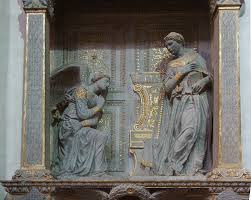Every work should be studied in its context (original physical location and
historical moment) in order to fully understand its meaning, but one way to approach the differences between artists and periods is to look at the stylistic differences between works.
COMPARISONS:
Giotto shows some interest in spatial
depth, but Veneziano’s is more proportional with bodies in space (bodies still
a bit large for 1-point perspective of architecture but more accurate than
Giotto.)
Light in Duccio and Giotto is holy light
rendered with gold leaf, but regular consistent light source of natural light
in Veneziano.
Not much interest in accurate anatomy in
Duccio and Giotto, more emphasis on emotional response of spectator. Accurate
anatomy and weight under drapery in Veneziano, spectator is actually addressed
by saint John in Veneziano.
No
signature of artist in Duccio and Giotto, Veneziano signs his work
across
the step in front.
Comparison of Adoration of the Magi –
Gentile da Fabriano, Masaccio, Botticelli -Look at the Gothic elements in Gentile as opposed to the Renaissance elements in Masaccio.


Uccello and Castagno – Generals on horseback in Duomo. Look at how













I first discovered your blog in May 2020 when I had been reading about the Sistine Chapel ceiling (my mother was doing a 1,000 piece jigsaw puzzle and wanted to know what she was seeing). I was curious about any relationship between Michelangelo and Dante -- and here you are!
ReplyDeleteMy own interest in art history (most periods but especially medieval and renaissance) is as a complementary field to my primary academic research (dissertation on Chaucer MSS and substantial work in Shakespeare) -- and I have always wondered how any literate human cannot be captivated by Dante.
I've looked into other parts of your blog and appreciate how much you lay out for "just anyone." And I admire the use you make of your own academic degree to teach the rest of us.
Thanks very much, and I hope you are well.
Lois Rem
Lois, thank you so much for your comment. I do hope to make the art of the Renaissance understandable to a general audience. I will be writing more about Dante and Michelangelo in a future blog, too. Your own work on Chaucer and Shakespeare gives you a rich perspective from which to see the art of Italy. I appreciate your reading my entries on it.
Delete